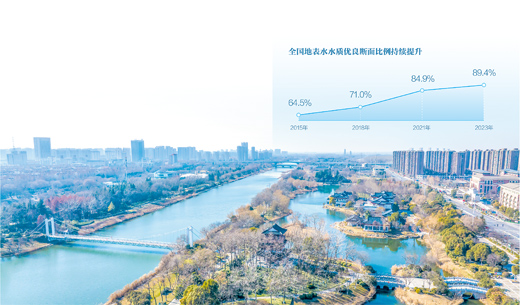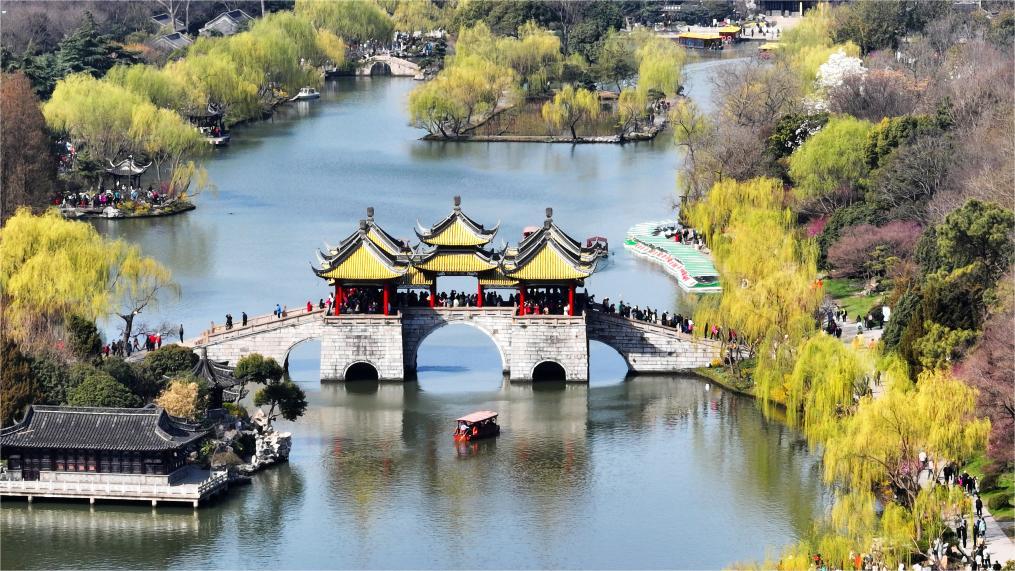China continues to keep waters clear
Regions and departments in China have taken strong steps to keep the waters clear, focusing on protecting water sources, dealing with dark and smelly water bodies, and protecting ecosystems of the Yangtze River and the Yellow River.
Thanks to these efforts, China has seen consistent improvement in the quality of the water ecological environment.

Cleaners work on the Liuchong River, a tributary of the Wujiang River, in Xinren Miao township, Qianxi city, southwest China's Guizhou Province. (Photo/Zhou Xunchao)
According to the Department of Water Ecology and Environment of the Ministry of Ecology and Environment, 89.4 percent of monitored sections had fairly good surface water quality -- at or above Grade III in the country's five-tier water quality system, almost reaching the level of developed countries and an increase of 27.8 percentage points since 2012. The share of surface water below Grade V, the lowest level, stood at 0.7 percent, marking an improvement of 10.2 percentage points since 2012.
China has better guaranteed drinking water safety. Since the 13th Five-Year Plan period (2016-2020), the country has carried out a special campaign to protect centralized drinking water sources.
A total of 10,363 problems found at 2,804 water sources at the county level and above have been rectified, ensuring drinking water safety for 770 million residents.
Planning has been completed on the establishment of protection zones for 19,800 drinking water sources at the township level. Over 1,300 water sources in urban areas nationwide have been included in the assessment of the country's pollution prevention and control efforts.

Tourists have fun in the Hanfeng Lake scenic area in Kaizhou district, southwest China's Chongqing Municipality. (Photo/Wang Xiaoyu)
China has eliminated dark and smelly water bodies at a faster pace. As of the end of 2023, such bodies were generally eliminated in cities at the prefectural level and above, while over 70 percent of those bodies were eliminated in county-level cities.
The Qinhuai River in Nanjing city, east China's Jiangsu Province is an essential tributary of the Yangtze River. Around half of the city's residents live in the Qinhuai River basin spanning 1,751 square kilometers.
"In the past, the water quality in the Qinhuai River was maintained at Grade V and its aquatic ecosystem was severely degraded, as a large amount of industrial and domestic sewage was directly discharged into the river due to rapid industrialization and urbanization," said Zhang Xiaofeng, director of the water environment department of the Nanjing water affairs bureau.
Zhang said that in recent years, Nanjing has carried out the systematic governance of the river, built or upgraded 16 sewage treatment plants, laid 470 kilometers of sewage collection pipes and rectified over 1,300 sewage outlets along the river. Meanwhile, the city has restored the water ecology of the river and gradually improved the functions of the aquatic ecosystems in tributaries like Yueya Lake and Xuanwu Lake, leading to several "underwater forests" and enhancing the water self-purification capacity.

Photo shows Chinese crested terns at the Minjiang River estuary wetland in Changle district, Fuzhou, capital of southeast China's Fujian Province. (Photo/Zheng Peiluan)
After years of comprehensive treatment, the Qinhuai River has seen clear waters and green shores again. The water quality of the river remains at Grade III or above. At the same time, wild white Amur bream, a first-class provincial protected animal in Jiangsu, has been found in the river. In October 2023, the Qinhuai River was selected as an excellent case of "beautiful rivers and lakes" in the country.
Similarly, the Nanming River, the mother river of Guiyang city in southwest China's Guizhou Province, was once a "lifeless river" due to serious pollution. It was also listed as an excellent case of "beautiful rivers and lakes" in the country last October, thanks to the city's integrated management.
China has also made significant progress in strengthening the ecological conservation of major rivers and important lakes. In 2023, the water quality at the mainstream of the Yangtze River reached Grade II for four consecutive years, while that of the mainstream of the Yellow River met Grade II for two straight years. The area, duration and density of cyanobacterial blooms in Taihu Lake were all at the lowest levels since 2016.

Photo shows the Ancient Yellow River Park in Sucheng district, Suqian city, east China's Jiangsu Province. (Photo/Xu Rui)
Baiyangdian Lake is the largest wetland ecosystem in northern China. After systemic governance, the water quality in the lake was improved from Grade V before 2017 to Grade III in 2021, and has maintained the level for three consecutive years. 276 wild birds and 48 fish species have been spotted at Baiyangdian Lake, surging by 70 and 21, respectively, after the establishment of the Xiong'an New Area, where the lake is located, in 2017.
With the building of a Beautiful China as the overarching principle and the improvement of the quality of water ecology as the core, China will take targeted measures and science-based approaches in accordance with the law and make concerted efforts to improve aquatic environments, water resources, and aquatic ecosystems to continuously keep the waters clear, according to an official of the Department of Water Ecology and Environment of the Ministry of Ecology and Environment.
Photos
Related Stories
- China's ecological environment improves steadily in 2023: minister
- Township in China's Hunan improves ecology, develops green industries
- In Numbers: China's ecological environment improves steadily in 2023
- China builds ecological monitoring network to better protect lucid waters, lush mountains
- China reaps fruitful results in ecological efforts
- China's Blue Circle environmental initiative gives new solution to marine plastic waste
- Yichun in NE China blazes new path of green development
Copyright © 2024 People's Daily Online. All Rights Reserved.









